Presentation of Colours
The Presentation of Colours is a ceremony that marks an anniversary or event in the history of a particular regiment. This involves the presentation of a new version of the regimental colour to a regiment or equivalent formation in the armed forces. This is a traditional ceremony that was pioneered by the British Armed Forces, and is today used in most Commonwealth countries.[1][2][3]
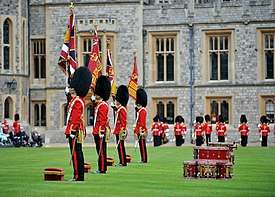
Background
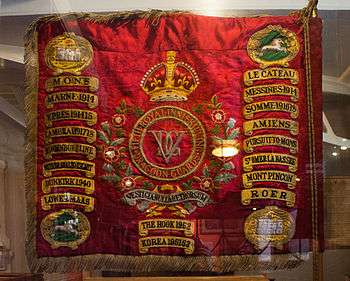
In the military, the colours originally acted as a rallying point for troops and as a way to locate the commander. It originated in Ancient Egypt around 5,000 years ago, with the practice also being used in the Roman Empire and the Roman army specifically. It was made more significant in the Middle Ages, when military colours were formalized with the coat of arms of the country. Colour guards at the time were introduced to escort the colour and to make sure that the colour never was damaged. Today, colours are no longer carried into battle, due to the creation of modern weapons, and the advancement of warfare. Colours are now used as part of a regiment's tradition and symbolizes the unit's identity and is used at events of formal character.[4][5]
The ceremony in most Commonwealth countries concern the entrustment to the concerned unit of either one or two colours, if for the latter case the colours are a Sovereign's or National/Presidential Colour and the Regimental Colour (for the infantry, air force combat commands and naval establishments, as well as military educational centers) or the Sovereign's/Presidential Standard/Guidon (for cavalry units and training establishments). As a matter of tradition, colours are never issued to the light infantry, artillery, engineers and support branches, although differences exist (like in the armed forces of India, Pakistan, Singapore, Malaysia, Sri Lanka (save for light infantry) and Bangladesh).[6][7]
Ceremony
_and_prestigious_President%E2%80%99s_Standard_to_the_125_Helicopter_Squadron.jpg)
The formation for the parade is a battalion-sized (100–500 soldiers) formation of military units of an armed forces formation from Commonwealth countries (from either the navy, army and air force). From 4 to 10 companies is the usual size of the parade and a military band combined with a corps of drums and/or pipes and drums providing the ceremonial music is present. The parade commander, the Field Officer holding the rank of a major or lieutenant colonel (commander or lieutenant commander in the navy, wing commander or squadron leader in the air force), takes his place in the center of the parade field, assisted by the Second-in-Command and the Parade Adjutant.
With the regimental colonel in chief usually being the reviewing officer during the ceremony (Other instances include members of the Royal Family in the United Kingdom/Commonwealth realms, the Governor General representing the Royal Family, the Crown Prince or King such as the one in Malaysia and Brunei, and or the President/Head of State for other countries or in other cases the service branch or armed forces chief from the armed forces or service branches in these countries [8]), upon his/her arrival a Royal/Presidential Salute from the regiment is executed and then the guest inspects the combined guard of honour from the regiment as the band plays a slow march, in addition to the optional firing of a 21-gun salute. If the guest if a military general or flag ranked officer, a General Salute is executed by the formation before the inspection can begin.
After the inspection, a stick orderly will walk to the rear of the formation to receive the pace stick from the regimental sergeant major (who has a billet of a warrant officer) who will then draw his/her sword (symbolizing the protection of the colours). The regiment's first company will then march in quick time, usually in Commonwealth realms, to the tune of The British Grenadiers (irrespective of the regiment), to which the ceremony proceeds in a similar fashion to the Trooping of the Colour ceremony in London, with the "Escort to the Colour" receiving the old colour so that they can troop it through the ranks of the rest of the regiment, preceded by a salute to the colours by the escort, usually with the band playing an abbreviated version of the national or royal anthem. At the conclusion of this part of the ceremony, the old colours of regiment will be retired, by the colour party in slow time (most likely to the tune of Auld Lang Syne in Commonwealth Realms). When the old Colours are retired, they are then laid up on a display (in the Regimental Chapel or the Officer's Mess for example) as it will never be paraded by the regiment again.
After this portion, members of the corps of drums will form a spiritual altar from their instruments, after which the quartermaster will at that point bring out the new colour and place it on top of the pile. Religious figures in the regiment (mostly from the Christian faith) will then give a blessing to the colours, the regiment, and the service branch.[9] With this portion being complete, the reviewing officer will briefly address the regiment of which he/she presented the colours to, which will be concluded with the speaker expressing confidence in the regiment and the regimental commander thanking the reviewing officer for their words. Following this the reviewing officer entrusts the colour/s, which had already been removed from the pile by NCOs earlier, to the colour ensign/s of the unit holding the rank of second lieutenant (or pilot officer or ensign/sub-lieutenant depending on the service branch).
Once the drummers and commanders retire to their previous positions (in the band and the regiment respectively), the new colours are then marched to their position in formation to the tune of the regimental march or the national anthem of the country in slow time. This will signal the start of the regimental march past for the reviewing officer who stands on a makeshift saluting base. While marching in slow time, the new colours will be lowered (flourished) to the ground to show respect to the reviewing officer, if in quick time, they are not.[10]
An Advance in Review Order is used to signal the end of the presentation of colours ceremony, by which the regiment offers a final Royal Salute/Presidential Salute (usually by presenting arms), followed by the optional three cheers. Following this, the guest departs from the tribune and the entire parade marches out with the new colours. If he or she remains, following the final report by the parade commander, the ceremony reforms to march past order to render a final salute to the guest, and the whole unit marches out in that manner with the band marching out last.
In Malaysia, the order of the presentation is different. Following the inspection of the line, the old colour is retired, followed by the presentation of the new colour, prayers and the speech, followed by the handover of the new colour to the ensign and the trooping of the newly presented colour through the ranks before the march past in both slow and quick time, as well as the performance of the state or national anthem if the reviewing officer is either the Yang di-Pertuan Agong or state sultans, who are the colonels-in-chief of their respective units.[11] In India, in reflection of the country's diverse religions, the colours consecration prayers are offered by military chaplains of religions represented in the Armed Forces (Hinduism, Sikhism, Christianity and Islam).
Until the mechanization of the cavalry regiments in Commonwealth armies in the 1930s, the form of the presentation of colours of cavalry regiments was done mounted by either the Sovereign or representatives of the British Royal Family, and the guidons or standards were, as in today, laid on timpani which also occasionally carried the regimental honors[12] or in the same drum sets as in the infantry if unavailable. Some light regiments only had timpani that carried the battle honours of the unit on parade until the 1950s.[13]
Notable and recent ceremonies
- 1863 – Royal Gurkha Rifles (Queen's Truncheon)[14]
- 30 May 1939 – Royal Canadian Navy[15]
- 21 April 1954 – Sri Lanka Light Infantry[16]
- 28 December 1954 – Royal New Zealand Air Force
- 3 June 1962 – The Seaforth Highlanders of Canada
- June 1997 – Governor General's Foot Guards[17]
- 5 November 2009 – Royal Regiment of Canada, and the Toronto Scottish Regiment[18]
- 22 October 2011 – Royal Military College, Duntroon[19]
- 3 May 2012 – 1st Battalion and No. 7 Company, Coldstream Guards[20]
- 11 June 2015 – Royal Welsh[21]
- 11 May 2016 – Royal Johor Military Force[22]
- 15 September 2016 – Royal Ranger Regiment
- 1 September 2017 – Royal Canadian Air Force[23]
- 10 July 2018 – Royal Air Force[24]
- 5 December 2018 – Royal Malay Regiment
- 24 March 2019 – Barbados Coast Guard[25]
- 1 June 2019 – 5th Battalion, Royal Australian Regiment
- 27 September 2019 – Corps of Army Air Defence
- 19 November 2019 – Indian Naval Academy
Variants in other countries
Germany
Military colours began to be presented by order of the Federal Ministry of Defence on 18 September 1964. This was a direct result of the production of unauthorized unit colours by army soldiers, which became illegal in the early 1960s.[26] The first German military colours were presented by President Heinrich Lübke to the ceremonial Wachbataillon (based in Berlin) on 7 January 1965. Colours are presented at the battalion and regiment levels of the Bundeswehr.[27] The presentation is presided by the Federal Minister of Defense, who serves as the commander-in-chief of the Bundeswehr in times of peace, or by the Inspector General of the Bundeswehr. Optionally the President presents the colour himself.
The Volksarmee of the German Democratic Republic (GDR) conducted similar ceremonies that resembled it's Soviet (and later Russian) counterparts.[28]
Poland
The ceremony of the presentation of colours (Polish:Uroczystość wręczenia sztandaru) to units of the Polish Armed Forces, the Police, Border Guard, State Fire Service and other uniformed organizations is a ceremony of great importance. The decree issuing colours to these organizations is issued by the superior authority of the responsible state ministry or by the President of Poland, for example, Armed Forces colours are granted to deserving units by decree of the Minister of National Defense.[29] The ceremony is mix of various influences, like German, Russian and British, while also incorporating elements from the Royal Commonwealth period like the blessing of the colours in the presence of the Catholic priest or bishop on the night of or before the presentation.[30] The reviewing officer is either a general or flag grade officer with higher billets and/or command responsibilities or a minister/deputy minister or chairman/vice chairman of the concerned government ministry/agency, or even the President himself in special cases.
Post-Soviet states
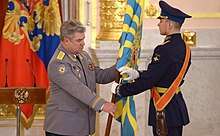
The presentation of colours in member countries of the Commonwealth of Independent States, and other post-Soviet states like the Ukraine, has significant differences with the British. The colours are known in Russia and many other CIS countries as battle flags, which have great importance in the armed forces. In the case of the Russian Armed Forces this ceremony is ordered by the Minister of Defence, who signs a decree awarding the colours to a unit, command or educational institution.[31] Decrees for the granting of colours to the uniformed forces of the Ministries of the Internal Affairs (Police, Drug Service and Migration Service), Justice (Federal Penitentiary Service and Federal Bailiffs Service) and Emergency Situations, as well as to the National Guard, the Federal Security and Protective Services, are under the authority of the Minister of the concerned ministry[32][33][34] or in the case of the other three the President of Russia. Similar orders are granted by ministers or by the office of the President or Prime Minister of other CIS countries, and Ukraine for the armed forces and public uniformed services of these countries. It can be held either outdoors in the military barracks or parade field or indoors in a theater or public hall. Optionally, like in Russia, and Ukraine, the President serves as the reviewing officer and can be assigned the duty of presenting the new colours to the unit concerned.
In addition to the militaries of post-Soviet states, the Mongolian Armed Forces have also adopted the presentation of colours ceremony from the Soviet Armed Forces. The order for the bestowment of colours to distinguished formations is similarly granted by the President or by government ministers/agency heads.
Outdoor ceremony
The formation for the outdoor parade is a battalion-sized (100–900 soldiers) formation of military units of an armed forces formation from CIS countries (from either the navy, army and air force, as well as public security formations in these countries). 4 to 14 companies is the usual size of the parade and a military band providing the ceremonial music is present. The parade commander is either a field grade or general/flag grade officer of the armed forces or public security formations while the reviewing officer can be a general or flag grade officer with higher billets and/or command responsibilities[35] or a minister/deputy minister or chairman/vice chairman of the concerned government ministry/agency.
Following the entrance of the national colour guard carrying the national flag (usually in Russia accompanied by the playing by the band of the March of the Preobrazhensky Regiment), the parade commander then marches off to inform the reviewing officer of the readiness of the parade to receive the concerned unit colours. Following the report, both march to the center of the parade grounds while the parade presents arms, following this the reviewing officer greets the assembled formation:
- Minister/Reviewing officer: Greetings, comrades!
Troops: Greetings to you (states rank/office title),sir!
- Minister/Reviewing officer: Greetings, comrades!
In Ukraine the addressing format is as follows:
- Minister/Reviewing officer: Glory to Ukraine!
Troops: Glory to the heroes, sir!
- Minister/Reviewing officer: Glory to Ukraine!
The parade is then ordered to stand at ease.
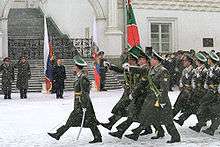
Following this, the new colour, which had already been marched in by a colour guard behind the reviewing officer, is being prepared to be removed of its casing. The right escort NCO of the colour removes the casing as the senior NCO, who serves as the ensign, dips the colour, thus revealing the new colour of the concerned unit, as the band plays a drumroll (in Russia the band then plays the Moscow Fanfare following it), after this the ensign dips the colour first to the right and then to the left before returning to the carry position. If necessary, religious figures (either from the Orthodox Church and/or Islamic (and if present, Buddhist) faith/s) will then consecrate the newly uncased colour. After the uncasing and players, the order on the entrustment of the colour is read out, following by the addresses of the reviewing officer and the commander of the unit that will receive the colour. The reviewing officer congratulates the unit on the reception of the colour, expressing confidence in the men and women who serve and the unit commander then replies to express profound gratitude on this occasion. After this the reviewing officer obtains the colour, which is then handed over to the commanding officer, the moment of which is then followed by the playing of the country's national anthem by the band. Then the unit commander hands over the new colour to another colour guard and its ensign, who, as the parade, presenting arms and in the eyes right position, shouts a threefold Oorah while the band plays appropriate music, together with the commander, troops the colour through the ranks before taking its place of honor in the formation. Following the trooping, the formation reforms to march past order to render a final salute to the reviewing officer, and the whole unit marches out in that manner with the band marching out last.
In Ukraine, following the presentation of the new colour, the commanding officer of the unit receiving its colour, following his report of the readiness to take care of the colour, first removes his headgear to touch the colour in the hands of the reviewing officer before handing it over to the unit's colour guard.
Thailand
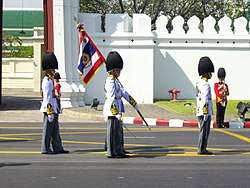
Each unit of the Royal Thai Armed Forces is given a colour called the "Thong Chai Chalermphol" (Thai: ธงชัยเฉลิมพล) or Victory Colours. These are presented to each unit personally by the King of Thailand. The flags are divided into four different designs, for: Royal Thai Army, Royal Thai Navy, Royal Thai Air Force and King's Guard units, and is presented in a public ceremony usually in December days following National Day celebrations.
Before their presentation the colours are ceremonially blessed in a religious ceremony attended by Buddhist monks and other high ranking dignitaries inside the Temple of the Emerald Buddha in Bangkok. During the ceremony amidst the chanting of the monks, the King will personally hammer the brass nails into the staff of each colour using a silver hammer. Each colour contains about 32–35 nails, in which the cloth is attached to the wooden staff. Within the same ceremony, the King will also take a strand of his own hair and conceal it within a compartment at the top of the staff, which is closed by a round silver screw top. The King will also attach each colour with its own ceremonial Buddha image, and bless each colour with holy water as monks chant a blessing to the new colours. The ceremony is steeped in Buddhist and Brahmic heritage, it symbolizes and cements the King's role as Chief Kshatriya (กษัตริย์) or Warrior ruler of his realm. It also emphasizes his constitutional role as Head and Chief of the Royal Thai Armed Forces (จอมทัพไทย: Chomthap Thai)[36] Following the Buddhist consecration, the colours, placed beforehand on a table, are then received by the commanders of the units that have granted their colours by decree of the Minister of Defence, and in a further ceremony outside the temple later on, are then handed over by the King to the colour ensigns of these units, who then return to their places in their respective colour guards with the new colours.[37]
See also
- Beating Retreat
- Guard mounting
- Posting the Colours
- Remembrance Day
- Trooping the Colour
- Battle honour
References
- "Presentation of Colours | The Royal Family". royal.uk. Retrieved 1 January 2019.
- Brown, Michèle (3 September 1983). "Ritual of Royalty: The Ceremony and Pageantry of Britain's Monarchy". Prentice-Hall – via Google Books.
- "Military Colours - Encyclopedia". theodora.com. Retrieved 1 January 2019.
- "The regimental system | National Army Museum". www.nam.ac.uk.
- Government of Canada, National Defence (17 August 2017). "Canadian Armed Forces Colours | RCAF Colours | Royal Canadian Air Force". www.rcaf-arc.forces.gc.ca.
- "Punch". Punch Publications Limited. 3 September 1846 – via Google Books.
- "h4". www.sainiksamachar.nic.in.
- "Journal of the Royal United Service Institution, Whitehall Yard". W. Mitchell. 3 September 1895 – via Google Books.
- The Encyclopædia Britannica: A Dictionary of Arts, Sciences, Literature and General Information. At the University Press. 3 September 1910. p. 730 – via Internet Archive.
Presentation of military Colours britain ceremony.
- "Sultan Kedah berkenan sempurnakan istiadat Pertukaran Panji-panji RAMD". www.bharian.com.my. 4 December 2018. Retrieved 3 September 2019.
- "The Guards Magazine". guardsmagazine.com.
- "RCAF Colours Presentation commemorative booklet - Sequence of Events". www.rcaf-arc.forces.gc.ca. Retrieved 14 March 2019.
- Baker, Margaret (2008). Discovering London Statues and Monuments. Volume 42 of Shire Discovering (5, illustrated ed.). Osprey Publishing. pp. 18. ISBN 0-7478-0495-8.
- "The Kings Colour of the Royal Canadian Navy". www.nauticapedia.ca.
- REGIMENTAL INSIGNIA,THE COLOURS OF THE REGIMENT, www.army.lk/lightinfan.php
- "Conrad Black: The rise and fall of a media tycoon". 5 December 2007 – via www.telegraph.co.uk.
- "TWO REGIMENTS TO RECEIVE NEW COLOURS FROM PRINCE OF WALES ON NOV. 5 | Ottawa Citizen". 3 November 2009.
- "Queen hails Duntroon once more". www.heraldsun.com.au. 22 October 2011.
- "Queen presents new Colours to Coldstream Guards". GOV.UK.
- Mosalski, by Ruth; 09:49, 11 Jun 2015Updated13:53 (11 June 2015). "Royal Welsh soldiers receive new colours from Queen". walesonline.CS1 maint: numeric names: authors list (link)
- Ahmad Fairuz Othman (15 February 2006). "Sultan of Johor carries out rare change of JMF colours". New Straits Times. Retrieved 11 June 2019.
- "Archived copy". Archived from the original on 7 September 2017. Retrieved 13 March 2019.CS1 maint: archived copy as title (link)
- "Thousands watch RAF's centenary flypast". 10 July 2018 – via www.bbc.co.uk.
- https://www.princeofwales.gov.uk/royal-visit-caribbean-barbados
- "Colour for Armed Forces Units (Germany)". www.crwflags.com.
- "Flag Legislation (Germany)". www.crwflags.com.
- "Presentation of colours to the First Mechanised Regiment of the National People's Army of the German Democratic Republic (30 April 1956)". CVCE.EU by UNI.LU. 8 December 2011.
- "Prezydent Andrzej Duda: dziękuję żołnierzom Pułku Reprezentacyjnego za służbę". PolskieRadio24.pl.
- Policja, Polska. "Uroczystość wręczenia sztandaru Komendzie Powiatowej Policji w Strzyżowie". Policja.pl.
- "Soviet Military Review". Krasnaya Zvezda Publishing House. 3 September 1984 – via Google Books.
- "Вручение знамени судебным приставам Тверской области -". r69.fssprus.ru.
- "Вручение знамени Федеральной службы судебных приставов". Президент России.
- "Торжественное вручение знамени Главному управлению МЧС России по г. Москве". www.mchs.gov.ru.
- "Вручення Бойового Прапору – знаменна та незабутня подія для військової частини | НГУ". ngu.gov.ua.
- ""พระบรมฯ"เสด็จฯ แทนพระองค์พิธีตรึงหมุดธง-พระราชทานธงชัยเฉลิมพล ช่วงที่3" – via www.youtube.com.
External links
![]()